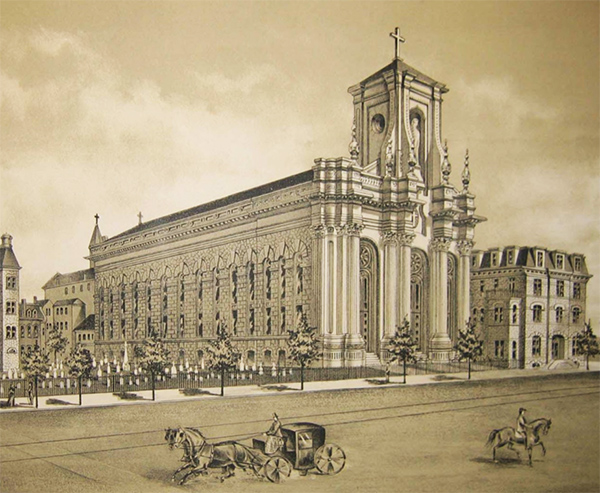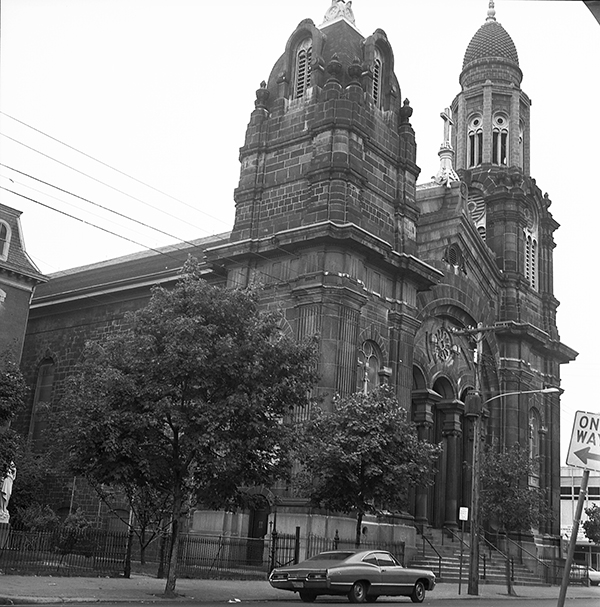
The National Guard’s Hall, completed in 1857, served as an armory for military drills but its 60-by-130-foot interior spaces made it an all-purpose venue of choice. Had it been completed a year earlier, its cavernous interior would almost certainly have been the site of the first Republican National Convention, a role that fell to the Musical Fund Hall near 8th and Locust Streets. According to the Historic American Building Survey, National Guard’s Hall would come to serve as a United States army hospital, a “destination point of military parades, the scene of much patriotic speechmaking, and the welcome and dismissal point for troops either on furlough or at the end of enlistment.” Its second-floor “grand saloon” which seated 1,800, regularly served as a venue for “lectures, fairs, concerts, balls” and gatherings of all sort.
The popular “Beck’s Band gave the first of their series of annual balls there largely attended . . . by a number of our most estimable citizens and their families.” reported The Inquirer in November 1860. The following Spring it housed the “Fourth Friendship Ball for the benefit of the St. Vincent’s Orphans Asylum.” Tickets were a dollar. By November 1862 the hall was transformed into a temporary Army hospital for Civil War casualties, 159 beds per floor according to Albert Liscom, a soldier from New England whose injured knee prevented him from marching into battle.
Edwin Forrest Durang, whose name suggests a theatrical rather than an architectural orientation, was responsible for the design. And scale, not style, was its primary asset—an accomplishment made possible by the use of 10 trussed girders, each 7-feet deep, spanning a sixty-foot width. That technology, combined with the premature death of John E. Carver, Durang’s employer, as well as the architect’s religious affiliation, positioned him to be the go-to designer for Catholic Philadelphia at a time of massive immigration and an increasing capacity to commission new buildings. By the end of the century, Philadelphia had 72 parishes and Durang would have established a monopoly as their go-to architect.
As architectural historian Michael Lewis tells us in Philadelphia Builds: “Durang made his debut as a Catholic architect with a pair of oversize parish churches,” St. Ann (1866-1869) in Port Richmond and Saint Charles Borromeo (1868-71) in South Philadelphia. “Each was a stone leviathan,” writes Lewis, and these churches “established the model that Durang would follow without significant modification for the next 45 years.” With “a spirited frontispiece, plain but solid walls to the sides, and a roomy auditorium of a space within,” these churches were “decorated more or less richly as the parishioners could afford.”


Durang’s churches tended to “vary wildly in style.” But “in one crucial aspect they are the same,” Lewis points out: “their façades have nothing whatsoever to do with the space behind. Like a piece of stage scenery, the extravagance ended at the front wall and did not go around the sides, which presented nothing more than an austere march of round-headed windows.” In essence, “there was little difference between a Durang auditorium and a church.”
Durang produced twenty of Philadelphia’s Roman Catholic Churches and renovated or rebuilt at least ten others. They included, among others, The Church of the Gesú and St. Veronica’s in North Philadelphia, St. Francis Xavier in Fairmount, Our Mother of Sorrows and St. Agatha’s in West Philadelphia, Visitation of the Blessed Virgin Mary in Kensington, St. Mary Magdalene di Pazzi and St. Gabriel’s in South Philadelphia. Most survive to this day, standing among Philadelphia’s more than 830 extant historic sacred places.

What didn’t survive? The National Guard’s Hall. Its demolition in 1959 helped clear the way for the northernmost block of Independence Mall, where the National Constitution Center now stands. If we no longer have the building, we do have photographs of its demolition revealing the truss, Durang’s “secret sauce” for creating a half-century of Philadelphia’s mammoth sacred and less-than-sacred spaces.
[Sources: Michael Lewis, Philadelphia Builds: Essays on Architecture (Philadelphia: Paul Dry Books, 2021); Gregory William Oliveri, Building a Baroque Catholicism: the Philadelphia churches of Edwin Forrest Durang (University of Delaware MA Thesis, 1999); Philadelphia’s Historic Sacred Places Their past, present, and future. (The Pew Charitable Trusts, October 2017) (PDF).]


One reply on “Edwin Forrest Durang’s “Secret Sauce””
Fascinating stuff, Ken.. The preservation of these gorgeous churches ought to be a civic mandate.